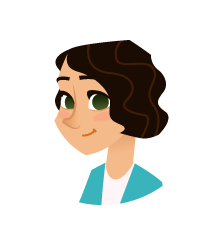 deutsch
deutsch Beginner’s Guide: How do I write the first blog post?
You have already come a long way, installed WordPress and made the most important settings.
Now it's starting so slowly and that's why we're now dealing with content planning and writing blog posts.
First of all, there is no optimal blog post, only many factors that influence the success of your content.
1. Understand your readers
Before you start writing one blog post after another, you should have a clear understanding of your target group.
Basically you write for your own visitors who read your blog. These readers support you in the social networks and share your content.
It is therefore useful to first think about the target group and ask yourself a few typical questions:
- Who reads my content?
- What content do my visitors want to read?
- etc.
If you're just starting out and you're not sure what your target group is, do research on relevant websites.
Read the comments there for example, this is an optimal way to find out directly what your target group wants.
Recommendation
Oh no, that's so much effort!
It's no use if you don't know your target group and write content that appeals to the wrong target group.
It is therefore best to write down the most important factors: Who is my target group and what content appeals to my target group.
2. Content planning and contribution topics
If you now know your target group, you need to make a rough content planning about which topics you want to write about.
If you already have some ideas for posts in your head, make a note of them immediately.
Continually complete and refine this initial content planning. Also, with the first beginnings of this sketch, a first structural order can be implemented.
Subsequently, overview pages can be created at any time to summarize the individual blog posts to topics.
Take, for example, this beginner's guide: How to start a blog
At the beginning the whole structure was not yet fixed, it was constantly refined and supplemented by readers' wishes.
At the beginning only the idea to single contributions of the guide was fixed, which had developed later only to a comprehensive beginner guide.
Even today we regularly add and update the beginner guide contents.
Why should you plan your content?
Of course, you can also just write on it. But if we look at the successful bloggers nationally and internationally, they all have one thing in common.
I'm sure you already suspect it.
Exactly. Every very successful blogger has organized himself in one way or another and follows a basic content planning.
However, this content planning is not rigid like a summary, but is constantly evolving and changing.
Keep your ideas in the content planning.
What content is suitable for my blog?
There are certainly several answers to this question and they certainly differ from website to website and from target group to target group.
It doesn't always have to be a post with 2000 words or more. No, even short contributions can be valuable for your readers.
Use and mix these types of posts on your website:
- Instructions: These contributions deal in detail with a specific topic and demand appropriate topic competence.
- Field reports: Easy to write and always well received by the reader.
- ToDos: Direct the reader to imitate immediately. The same applies to checklists, samples and a guide.
- List contributions: One of the most popular types of content. Just be careful not to make lists too long.
- Statistical contributions: Regularly achieve a high degree of dissemination and good attention. But more elaborate to write.
- Brief instructions: This article gives readers a number of tips to make something faster and better. Not as comprehensive as manuals.
- Summaries: Can be implemented quickly and easily. Several existing articles are combined into a superordinate topic.
- Interviews: Are easy to get and both the interviewee and reader like interviews.
- News: Always well received, but they should not be copied 1:1.
- Product Reviews: Are easy to write and draw attention to the respective manufacturer, company or website.
- Free stuff: Should match the theme of the website and can be presented in the form of freeware, vouchers, e-books, etc.
3. The Headline
The headline, also called title or heading, is one of the most important influencing factors on your website.
This decides whether a visitor wants to read this post or how search engines position this post in the search engines.
Even if the content of your contribution could be super valuable for this visitor, it would be a great pity if your headline did not address him.
Note: Due to a weak headline you lose a lot of potential.
So that this does not happen to you, you should deal intensively with this factor, so that a click incentive for your visitors is given.
This headline is used both on the website of your contributions, as well as in the RSS feed or in the social media and is the first thing the potential visitor gets to read.
Tips for better headlines
It is not always possible to formulate a great headline, so the following tips should help you:
- Explain why the visitor should read this post.
- Your headline should describe the content of the post in a few words.
- Use strong words to get more attention.
- The 1-2 most important keywords should be included in the headline.
- A headline should not be too long, try to keep it simple and short.
- Numbers work very well in headlines.
- Use an active formulation to address the visitor.
20 eye-catching headlines
Many websites and their TOP contributions can be evaluated across all topics. The most frequently used components of well-visited articles are:
- 10 steps to ...
- 20 ways around ...
- 8 tips to ...
- 15 Reasons for ...
- Like me ...
- Like you ...
- Thousands are already making ...
- Why everyone ...
- You want to know ...
- The ultimate guide ...
- A simple way ...
- Top 10 ...
- Only until ...
- The secret of ...
- The truth about ...
- The most beautiful ...
- The three most beautiful ...
- 22 Rules ...
- 5 strategies ...
- 8 Tools ...
Surely there are more strong headlines.
Watch how others write their headlines in the future and complete your personal list.
4. The Post
Now you should have a topic and can start writing.
Even if the following may seem overwhelming at first glance, corresponding automatisms appear after a short time.
Breakdown
Start with a rough outline. Contributions on the Internet are harder to read than a book or newspaper.
A structure helps the reader to find his way around, to get to the information faster and to read your contribution better.
Use H2 to H6 formatting for your subheadings for a better representation.
Preface
When writing a gripping introduction, the first sentence is especially important. If it's easier for you, think of it as a headline.
The introduction must be tempting, arouse curiosity and create tension in the reader.
Above all, however, it should be short, crisp and concise.
Easily understandable writing
The aim is to write in an easy to understand and elegant way, so limit the text to the essentials.
Avoid writing long sentences with countless commas. A good sentence has a maximum of 20 words and 1-2 commas.
But it's not about bending or completely changing your writing style. Your own style should still be recognizable.
Formatting
Formatting is essential for good legibility. Some make the mistake of using abstract fonts or particularly conspicuous text colors.
Your content should be presented in a pleasant font color and easy to read font size.
Make sure that the line spacing is easy to read and that links visually stand out from the text content.
Paragraphs
Paragraphs, similar to formatting, ensure good legibility. Nobody likes to read through an almost endlessly long continuous text.
Paragraphs and enumerations are better perceived by the reader and ensure a good flow of reading in your articles.
The reader stays longer and increases the chance of a conversion, because the visitor deals with the content.
Images
The article image in WordPress is intended to represent the article or the page at a glance.
Only pictures complete the overall impression of your contents. Many neglect this factor, but it is not so difficult to find suitable pictures for the contributions.
Learn how to add images and where you can even get royalty-free images.
Links
Your contribution is now almost complete. Now it is still necessary to make appropriate links. Remember, there are 2 types of links (external and internal).
Wikipedia demonstrates it and links in a brutal frequency with all keywords to internal posts.
We recommend not to overdo it at this point and to set at least 3 internal links, depending on the text length.
Proofreading
You're not quite done, but you're close! The editing process is an important part of writing and should not be neglected.
It is all about editing spelling mistakes, wrong punctuation marks, if another word is used here and there, the sentence could become even more qualitative.
If you have no one who can proofread or edit your finished article, it is often worth copying and pasting it into Microsoft Word.
The spellchecker there will quickly show you a few careless mistakes. It is also recommended that proofreading be carried out with a certain time interval.
SEO
After the post is finished, it has to be optimized for search engines.
Your content can't do without search engine optimization.
If you are not yet using an SEO tool that supports you, then at least one meta description should be created for the post.
5. Call to Action at the end
At the end of each article, a Call to Action (CTA) should be included that specifies what the reader should do next.
These could be, for example:
- Subscribe to this blog.
- Download an e-book, guide or checklist.
- Register for an event or webinar.
- Read similar posts.
- Share this content.
- Leave a comment.
- Participate in the survey.
Again, don't overlay the reader with tons of call to action functions, sometimes less is more.
Overcoming writer's block
Everyone inevitably gets to the point where writing will be difficult. There are many reasons for this.
Some people are not particularly interested in a particular niche topic and are struggling to find the right content structure or it is simply a tough, dry topic.
The following writing strategies are worthwhile themselves around fresh wind into the own texts to get or also simply only, in order to write without trouble, better contents.
Just give it a try.
Follow the flow
Everyone knows that, the ideas are just bubbling out of you and writing is easy for you.
One sentence results in the other and the contribution is effortlessly finished.
Afterwards, make sure you take the time to read through and revise your texts again.
Especially beginners often tend to publish the first version directly.
The assembly
During the editing process you compile content from other websites, which later serve as inspiration for you.
Research good text passages with definitions, explanations, examples, advantages and disadvantages.
Then you assemble all text passages to a working text.
Now use this text as a template to express the content in your own words.
The no-back strategy
Who does not know this, the deadline is tomorrow and the sheet is still empty. But nothing works anymore, then use the no-back strategy.
Hit the keys, write wildly and write down anything you can think of on the subject. Do not pay attention to any structures or outlines. The only key that's off-limits: Delete.
You can't publish the post directly, but now you have something to work with.
Conclusion
It's not so much about making an optimal contribution.
But there are some factors to consider when writing blog posts that both readers and search engines prefer your content.
Many of the tips listed here will be implemented both consciously and unconsciously in the long term.
Therefore, summarize the points that are important for you once again and check at regular intervals whether you continue to implement them.
For further information we recommend our beginners guide, where you will find a lot of useful information about WordPress.
If you liked this post, please subscribe us on Facebook and Twitter.







 2011-2025
2011-2025